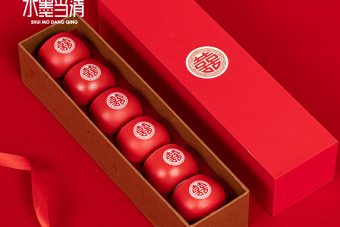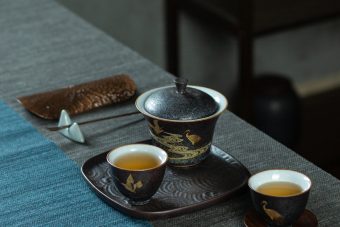Showing 1–16 of 101 results
-
New

Celestial Orchid Tea Set
More infoChinese Hand-Drawn Orchid Tea Set Immerse yourself in the ethereal beauty of ...$177.98 Add to cart -
New

Ruyao Peach Blossom Tea Set
More infoPeach Branch Ru Kiln Kung Fu Tea Set Gift Box Indulge in the exquisite artistry ...$252.98 Add to cart -
New

Celadon Ruyao Pink Lotus Tea Set
More infoEnchanting Red-Bodied Pink Ru Kiln Tea Set Indulge in the exquisite artistry of ...$169.98 Add to cart -
New

Jingdezhen Double-Walled Dragon Tea Set with Matching Tray
More infoJingdezhen Double Wall Dragon Tea Set With Tea Tray Immerse yourself in the ...$149.80 Add to cart -
New

Mi Yao Traditional Chinese Tea Ceremony Tea Set
More info## Enhance Your Tea Experience with the Exquisite Mi Yao Chinese Tea Ceremony ...$85.96 Add to cart -
New

Enthralling Blue Furnace Glaze Chinese Tea Set
More infoBlue Furnace Transmutation Chinese Tea Set Experience the unparalleled beauty ...$60.12 Add to cart -
New

Jade Porcelain Lotus Gaiwan Tea Set
More infoExplore the Art of Tea Perfection with the Jade Porcelain Lotus Gaiwan Tea Set ...$64.98 Add to cart -
New

Red Chinese Tea Set with Exquisite Gift Box
More infoChinese Red Tea Set with Gift Box Indulge in the exquisite artistry of this ...$67.25 Add to cart -
New

Celestial Geyao Tea Set with Lotus Incense Burner
More infoGeyao Tea Set with Lotus Incense Holder: An Artistic Tea-Drinking Experience ...$69.98 Add to cart -
New

Chinese Blue Tea Set with Gilded Handles
More infoAn exquisite symphony of porcelain artistry awaits you in the Chinese Blue Tea ...$154.98 Add to cart -
New

Celestial Sea of Cranes Porcelain Tea Set with Backflow Incense Burner
More info## Exquisite Chinese Sea Wave Crane Tea Set with Incense Burner ### ...$70.76 Add to cart -
New

Chinese Orange Tea and Travel Teaware Set
More info## Chinese Orange Tea Set with Travel Set: Experience the Art of Tea Perfection ...$108.98 Add to cart -
New

Luxurious Automatic Crane Tea Set Adorned with Sterling Silver
More info**Automatic Crane Tea Set With Sterling Silver** Indulge in the serenity of ...$159.98 Add to cart -
New

EarthenwareChinese Fruit and Tea Tray Set
More info## Chinese Fruit Tea Set with Tea Tray: An Exquisite Tea Experience Indulge in ...$79.98 Add to cart -
New

Versatile Japanese-Style Travel Tea Set
More infoExceptional Multifunctional Japanese-Style Portable Tea Set Immerse yourself in ...$100.88 Add to cart -
New

Orange Stoneware Travel Kung Fu Tea Set
More infoKung Fu Tea Set: A Portable Haven for Tea Lovers Prepare exquisite tea ...$86.76 Add to cart
The development history of Chinese tea sets is closely related to the emergence of tea drinking, and has gone through the process from none to have, shared to dedicated, rough to exquisite, with the prevalence of tea drinking, tea sets are constantly improving, developing, and more and more types.
The Tang Dynasty
By the time of the Tang Dynasty, tea had already become a daily drink for people, with more emphasis on the pleasure of drinking tea. Tea sets not only serve as utensils, but also have practical and appreciative values. The texture and artistic value of the tea set are taken into consideration in order to improve the color, aroma and flavor of tea. Lu Yu’s “Tea Classic · Four Vessels” recorded various types of pan-brewed tea vessels in the Tang Dynasty. At that time, noble families mainly used gold and silver teaware, while ordinary people used pottery teaware. Those who pay attention to life had a complete set of milling tea, brewing tea and drinking utensils, which shows that brewing and drinking tea were very popular in the Tang Dynasty.
Fried tea originated from boiled tea, which means grinding fresh leaves into powder, putting the tea powder into boiling water when the water reaches the second boil, and the tea is fried when the water reaches the third boil. The color, scent, and taste of the brewed tea remain in its most original form.
The Song Dynasty
The custom of drinking tea flourished during the Tang Dynasty and reached its peak in the Song Dynasty. In comparison to the Tang Dynasty, teawares in the Song Dynasty were simpler and more elegant. Apart from gold and silver, pottery was widely used. At the same time, drinking tea became increasingly popular. The most representative historical record of the Song Dynasty is “Tea utensils Praise” written by an elderly man named Shen An in the Southern Song Dynasty, which depicts 12 kinds of teawares for drinking and preparing tea through white sketching and names them “the twelve gentlemen”.
The method of Point Tea became popular in the Song Dynasty. Point Tea is to grind tea leaves into powder, put them into a teacup, add a little boiling water, whisk it into a paste with a tea whisk, and then pour in boiling water while stirring until the powder floats up to form a porridge-like surface that can be drunk. Point Tea in the Song Dynasty was also used for the extremely popular Dou Cha at that time.
Yuan Dynasty
The tea ware of the Yuan Dynasty was not well developed, mainly retaining the characteristics of the Song Dynasty. But due to the relationship of the nomadic ethnic group in the Yuan Dynasty, scattered tea began to rise, and tea ware also developed towards a bold and heavy direction.
Ming Dynasty
In the Ming Dynasty, the processing and drinking methods of tea changed a lot, and the teaware also underwent great changes. Jingdezhen porcelain and blue-and-white porcelain emerged as an unrivaled force, becoming popular in China and even famous abroad. At that time, kilns mainly produced white and delicate tea sets. Meanwhile, “tea washing” appeared, shaped like a bowl with a small hole at the bottom for washing tea leaves before drinking. After the mid-Ming Dynasty, porcelain pots and purple sand pots appeared, giving rise to the idea of “pottery fun”.
Qing Dynasty
In the Qing Dynasty, the types of tea sets were basically similar to those in the Ming Dynasty. The main ones were porcelain and purple sand. Among them, porcelain from Jingdezhen and purple sand from Yixing were the most outstanding. The development of Jingdezhen’s colored porcelain was greater than that in the Ming Dynasty, and new varieties such as famille rose and powder color were created at the same time; In addition to basic use, Yixing’s purple sand also integrated new art forms such as painting, poetry, calligraphy and seal carving, making purple sand pots have higher artistic value. In addition, bamboo and wooden tea sets from Sichuan Province and lacquer ware from Fuzhou also appeared successively.
Modern
Currently the market still popularizes “Jingdezhen porcelain and Yixing pottery” most, however, the types and styles of tea sets are more diversified, with better quality.
Experiencing Tea: More Than Just a Drink
Using a Chinese tea set is an experience that transcends mere tea drinking. It’s a ritual that calms the mind and soothes the soul, offering a moment of tranquility in our busy lives. The act of preparing and savoring tea in these exquisite sets is a journey through history, culture, and art.



